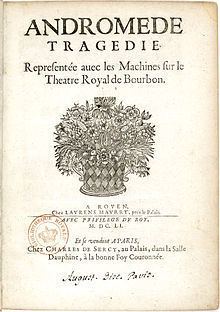Originally published 1651 | ||
 | ||
Similar Mélite, Clitandre, Nicomède, Comtesse D'Escarbagnas, Mithridate | ||
Andromède (Andromeda) is a French verse play in a prologue and five acts by Pierre Corneille, first performed on 1 February 1650 by the Troupe Royale de l'Hôtel de Bourgogne at the Théâtre Royal de Bourbon in Paris. The story is taken from Books IV and V of Ovid's Metamorphoses and concerns the transformation of Perseus and Andromeda. The play has rarely been revived and is mostly remembered today for the set of six engravings by François Chauveau depicting the elaborate Baroque set designs of Giacomo Torelli.
Contents
Background
The play was commissioned by Cardinal Mazarin in 1648 but wasn't finished until 1650. Corneille dedicated the piece to an unknown woman designated by four uppercase M's. According to Abel Lefranc, the M's represent Madame de Motteville, the confidante of Anne of Austria.
Plot
Premiere
The premiere production incorporated spectacular scenery, set changes, and special effects, designed by Giacomo Torelli. Many of the sets were recycled from Torelli's production of Luigi Rossi's opera Orfeo, performed at the Palais-Royal in 1647. A series of six engravings created by François Chauveau, depicting scenes from the prologue and five acts of Andromède, were published in Rouen in 1651, both separately and with the second edition of the play. Charles d'Assoucy composed incidental music, which included airs, duets, and choruses, that primarily functioned to cover up the noise of the stage machinery during scene changes and special effects, such as the descent of Jupiter, Juno and Neptune in the final act. Corneille did not look too favorably on the music: "I have employed music only to satisfy the ear while the eyes are looking at the machines, but I have been careful to have nothing sung that is essential to the understanding of the play because the words are generally badly understood in music." Most of the music has been lost, except for two choruses published in Airs à quatre parties (Robert Ballard, Paris, 1653).
